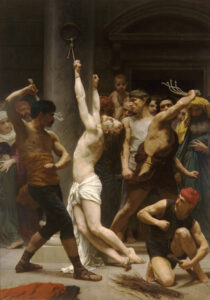
Resurrection: The Swoon Theory
Stop me if you have heard this one. A school kid needs to take a test. Just before it’s time to leave, the child proclaims they are sick. They don’t feel good, stomach hurts, headache. Suddenly a thermometer is produced with a reading that would send a human being to the hospital, stat! But then it is explained that today is Pizza Day for lunch, there is a book fair, and the kiddo has $20 to spend, their friend’s mother is bringing in cupcakes, and the whole class is getting an extra long exercise hour. This is all happening today, “and you will miss it if you can’t be there.” Suddenly, the kiddo is healed of all maladies, and they are ready to face the day, test or not. The younger sibling comes up and says in the ear of the “healed” kiddo, “Faker!”
Starting in the 18th century, skeptics like this younger sibling launched a scholarly effort to reconstruct an “authentic” as opposed to a “theological” picture of the life and ministry of Jesus. This Historical Jesus “movement” was a product of Enlightenment skepticism that intended to present a “historically accurate” Jesus that was to stand over against established, orthodox Christology. In some cases, historical facts were separated from supernatural events, looking for “natural explanations” of miracles and wonders. Even Thomas Jefferson pieced together a version of the New Testament “shorn of any sign of the miraculous or supernatural in order to leave just the life and teachings of Jesus behind.”
The resurrection was one of those difficult, supernatural events. How could a dead man being raised to life again have happened “naturally?” If you have been reading past Compass articles, you have read three accounts that have been used to explain the unexplainable. Yet one more way to explain the resurrection of Jesus Christ was that he didn’t really die on the cross at all. Perhaps, advocates of this view suppose, he just passed out or he swooned. When Jesus “gave up the ghost,” crying out, “Father, into your hands, I commend my spirit,” he merely fell unconscious.
 Jesus had suffered beatings at the hands of the Sanhedrin guards, and a vicious Roman flogging. Then he carried his cross about 400 yards (1/4 mile) to the place where Simon of Cyrene takes it from his exhausted hands. What person could survive this? After all this, having been crucified, without flinching, he suffers the pierce of a Roman Pilum releasing blood and water and is taken down from the cross. If Jesus survived, this was indeed a miracle.
Jesus had suffered beatings at the hands of the Sanhedrin guards, and a vicious Roman flogging. Then he carried his cross about 400 yards (1/4 mile) to the place where Simon of Cyrene takes it from his exhausted hands. What person could survive this? After all this, having been crucified, without flinching, he suffers the pierce of a Roman Pilum releasing blood and water and is taken down from the cross. If Jesus survived, this was indeed a miracle.
Ignore the blood and water at the piercing of his side, a sign of mortality, and consider that after his torture, he supposedly had the strength to roll away that stone from the tomb.
If all this was a lie—if Jesus simply swooned upon the cross and never died to begin with—C.S. Lewis is correct: Jesus Christ is the most diabolical person in history. Given the evidence amassed above, the so-called Swoon Theory would have required just as much supernatural intervention as his resurrection did. Needless to say, Jesus wasn’t faking it. He was not unconscious, he was dead.
It is unlikely that anyone reading this here thinks that Jesus just passed out and escaped. Nonetheless, there are those with whom we will share the faith who may have heard this lie. The spirit of skepticism is very much alive, and lots of folks want to fit Jesus into the smallness of their imagination. The events of Easter are daunting, frightening, and amazing. No one gets out without dealing with the love that raised Jesus—not from unconsciousness, not from a swoon, but from death to life. Jesus is not faking it. He is alive!
Dcn. Mathew Allen

